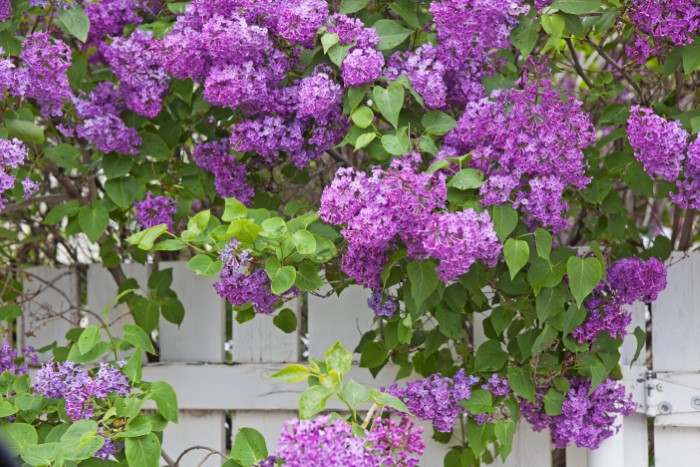Tough and hardy on the inside and beautiful and fragrant on the outside, you get the best of both worlds with lilacs! Considered by many gardeners to be the official sign of spring, lilac flowers are a true delight after a long, cold winter. This lilac grow guide covers all the important details you need to know in order to enjoy the most lilac blooms possible!

Whether it is seeing lilac blooms adorn the Easter dinner table or how it smells like grandma’s perfume, I feel like everyone holds some nostalgia for the lilac plant. Lilacs are a traditional flower that will never fall out of “trend” it seems!
I first fell in love with lilacs as a child. The sweet blooms were a perfect gift to give my mother, aunts, and teachers. Then when I bought my first home, it came with a grandmother lilac tree. She had a mossy, thick trunk and an abundance of blooms. That tree was the cornerstone of the back garden and I did everything I could to keep her happy. She provided me with many mason jars of blooms over the years.
Most famous for their sweet scent, you can make lilacs a part of any fragrance garden as the spring flowers are highly aromatic. Better yet, cut a few lilac flowers and bring them indoors where they will perfume the entire house. In fact, these blooms are one of my top 10 favorite fragrant flowers.
Lilac plants are traditionally large shrubs, reaching around 20 feet tall. However, many cultivars are available ranging from 4 feet all the way to 30 feet. So basically, there’s a little bit of something for everyone when it comes to finding the perfect lilac for your home.

History & Symbolism of Lilacs
The purple lilacs were used to symbolize first love and the white lilacs were used to symbolize youthful innocence. Who knew such an old-fashioned plant could be so popular symbolically with the young people?
According to Greek mythology, the story of the lilac (Syringa vulgaris) starts with a nymph named Syrax. Pan, the god of forests and fields, was captivated by her beauty and chased her through the forest. Frightened by his affections, Syrax escaped by turning herself into a hollow willow reed, much like the wood of the lilac shrub.
The genus name for the lilac comes from the Greek word syrinx, which means pipe or tube. Stems from the lilac were once hollowed out and used for reed pipes and flutes. It seems Pan was onto something!
Lilac Varieties
For those looking for variety, lilacs have your back. There are anywhere between 25 and 28 species of lilac, and they have extensively crossbred into dozens more. So much so that horticulturists and gardeners have trouble telling the different lilac plants apart!
Given the many cultivars and extensive crossbreeding, there are many different colours and options for lilac flowers. The typical flower presentation is oval and multi-stemmed, while some are upright and some are drooping. They also have two main flower types: single-flowered and double-flowered.
Here are some of the most notable varieties:

Syringa Vulgaris
The best-known lilac, this variety is referred to as the common lilac. It can grow as high as 20 feet, but most often blooming at eye level. The common lilac tends to be the most fragrant, offering that delightful smell we recognize lilacs for.
Syringa Persica
Known as the Persian lilac, this variety grows up to 10 feet high. The flowers are fragrant, pale lilac-coloured blooms that are half the size of the common lilac.
Syringa Chinensis
The Chinese or Rouen lilac is a cross between the common and Persian lilac. It is taller than the Persian, but otherwise, the fragrant, lilac-coloured flowers are the same as the common. The flowers appear in greater abundance, however.

Syringa Palebinina
For those looking for an itty bitty lilac, try the dwarf Korean lilac. It grows no higher than 4 feet and works well as a shrub border or in the flower garden.
Syringa Amurensis
On the opposite of a dwarf lilac, you have a tree lilac. They resemble small trees and can grow up to 30 feet. In summer, the trees produce great clusters of off-white blossoms. A Japanese variety of the tree lilac produces huge clusters of yellow-white flowers.
How to Grow Lilacs
Where to Plant Your Lilac Bush
Let your lilac bask in the sun and it will be happy! Lilac plants prefer full sun and need at least 6 hours of it a day to grow well. When choosing a place to plant your lilac, make sure it is somewhere with enough sun.

While lilac bushes need room to grow, but they can grow in a garden setting as well. The best place to plant a lilac bush is in an open area with good drainage. Lilac shrubs have bushy, rounded growth that is very dense, making them suitable for a loose hedge or screen planting.
When planting next to a house, be mindful of the variety. I personally love the idea of lilac adoring my house, but you also may not want one of the larger varieties blocking a window. Dwarf and common varieties work best next to houses.
The best soil is not too rich and is neutral or slightly alkaline. However, they will grow well in all types, except for highly acidic soil. To make the soil more fertile, mix in fertilizer high in phosphate and potash and low in nitrogen. Bone meal is a great choice as it contains lime that will sweeten the acid.
When to Plant Lilacs
The best time to plant lilacs is in the fall after the leaves have fallen, but before the ground freezes. You can plant in the spring, but this is only recommended if the winters are very severe. Planting in the fall gives the shrub a greater chance of survival because the roots have a head start in spring.

At first, your lilac will not flower. After a lilac is 3-4 years old, it will begin flowering. Depending on the age of the lilac you purchase, it could bloom the following spring after you plant it.
All lilacs will grow at least 6-8 inches each year, which is fairly quickly! You will have a big, full lilac shrub in no time.
How to Care for Lilacs
Water
Gardeners should provide lilacs with plenty of water when they are newly planted, but make sure the soil is well-drained to prevent root rot. After the lilac is well established, however, they very rarely need extra water unless in a drought. Mulching around the base of the lilac bush should be enough to encourage moisture retention, as well as manage weeds.

Pruning
Lilac care is simple…leave the bush alone! Your lilac will do well on its own for the first 3-4 years as it grows. Instead, let it grow and develop several branches from the base. This allows you to trim only the parts that are sticking out or have been attacked by disease or pests.
If you do decide to do any pruning for shaping or strengthening the lilac bush, prune only in spring as any other time of the year will result in a loss of blooms. You can also remove any suckers that grow from the base of the lilac.
Deadheading, on the other hand, you will definitely want to do in order to encourage more blooms and bushier growth. After the gorgeous flowers have come and gone, get out there with your pruners before the seeds set and remove the old flower heads. You’ll be rewarded with even better blooms next season. Read more about how to deadhead and why it’s important here.

Pests
A hardy plant, there isn’t much that can get to the lilac. Powdery mildew is the most common disease and it appears as a white, dusty substance on the leaves in the summer.
Your best bet at tackling powdery mildew is through prevention. Shady spots will make the lilac more prone to fungal disease as well as overly wet or crowded foliage.
Other less common pests that you may encounter include oyster-shell scale and San Jose scale which pierce the bark and suck sap from the wood, and lilac borers that burrow into the wood. Their larvae usually concentrate on old branches but sometimes like new growth.
How To Cut Lilacs
If you’re growing lilacs, you must bring some into the house. That’s a command! They make for such great cut flowers, filling the home with their famous fragrance and pretty pastel tones. I always like to spread the love and arrange these homegrown flowers as a gift for a loved one.

To harvest your lilac flowers for indoors, go in the early morning after the dew has dried. Take a clean, sharp knife and cut a few inches longer than the desired stem length. Cut just above a leaf, bud, or branch junction. Submerge your lilacs in a pail of water so the stem is not exposed to air while still outside.
Fill a vase with clean, lukewarm water and a floral preservative. Quickly transfer your lilac flowers to a vase and arrange for display, trimming any leaves or small stems. Cut the stem in an X so that it splits to absorb more water. Place them somewhere out of direct sunlight, and voila, spring has arrived!




This is a great post. Planting Lilac this year!!
I have loved your blog since I found it s couple of years ago. It’s one if my go-to’s. And I just wanted to tell you what fun I am having with your puzzle if the day! It was an unexpected surprise the other day and now I am addicted! Lol Thank you for providing such a rich, abundant and fun blog!
Fondly ~Shel Choate
p.s. I would love to add a puzzle plug-in to my blog. Can you tell me what you use?
Hi Shelley, it’s part of slickstream. I’m glad you are enjoying it.